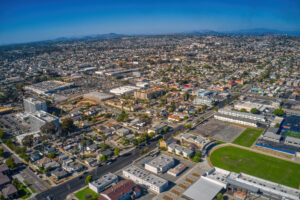The project reported here represents community partnership work between the city of National City and San Diego State University (SDSU) students. Operating under the university’s Center for Regional Sustainability with grants from the US Environmental Protection Agency (EPA) and the California Department of Toxic Substance Control (DTSC), the SDSU Brownfields Project intends to identify and prioritize brownfield sites in National City. As part of this work, students produced a comprehensive brownfields reuse plan for National City that combined a strong vision, creative policies for brownfield redevelopment, a summary of existing and projected conditions across several dimensions, and a plan for community engagement into a cohesive whole. The project brought together Masters program students from the School of Public Affairs in Dr. Valerie Stahl’s course, Seminar in Land Use Planning Principles and Techniques (CP 690), during the Spring 2024 semester. Throughout the class, students used a combination of existing publicly-accessible data and site visits to create both regular progress reports and a final report, which was presented to various leaders from National City and the Sage Project at the end of the semester. Section II of this report provides an introduction to the report. It describes the community partner’s goals, how students and faculty collaborated with the partner to explore the subject of brownfields in National City, and the process by which students created their draft reports. Section III provides readers with the background information and context necessary to understand the report. It describes the plan’s overall vision for brownfields in National City and the framework and principles that led to that vision. It also features a discussion of consistency between this and other National City planning documents. Section IV describes the existing and projected conditions of National City. This includes where brownfields are currently located, existing land uses, projected socioeconomic, demographic, and population trends, forecasted housing growth, parks and open space needs, and future land uses in the city. Section V introduces the history and purpose of community engagement in brownfields reuse planning and highlights stakeholders in an Actors Analysis. This section contains six overarching goals, each with its own recommended objectives and policies. Section VI describes how brownfields could be redeveloped to assist with the production of housing in National City. Its recommendations include identifying corridors capable of withstanding increases in density, setting a minimum affordability period for new affordable units, and redeveloping a brownfield under a Community Land Trust framework. Section VII describes how brownfields could be redeveloped to assist with the creation of parks and open space in National City. Its recommendations include redeveloping brownfield sites into community gardens and including recreational infrastructure and native plants in brownfield parks. Section VIII describes how land use policy could enable a better National City, with the assistance of brownfield redevelopment. Its recommendations include restoring wetland habitat through brownfield redevelopment, developing educational facilities on brownfields, and prioritizing certain brownfields for mixed-use complexes. Section IX contains three proposals for redeveloping specific brownfield sites in National City. Section X concludes the report and summarizes key themes and recommendations.
Site Search:
Menu

National City Comprehensive Brownfields Reuse Plan
Valerie Stahl
Metrics
- University San Diego State University
- Sustainable Development Goals 03 Good Health and Well-Being, 04 Quality Education, 09 Industry Innovation and Infrastructure, 10 Reduced Inequalities, 11 Sustainable Cities and Communities, 12 Responsible Consumption and Production, 13 Climate Action, 14 Life Below Water, 15 Life on Land
- University Department Planning and Public Affairs
- Lead Local Gov / Community Partner Org Name National City